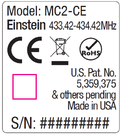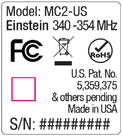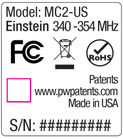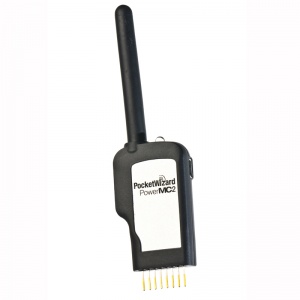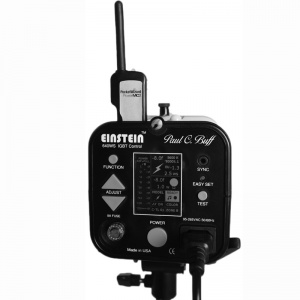Difference between revisions of "PowerMC2"
(→Channels and Zones: major overhaul) |
m (→Setting up your PowerMC2: added "based on transmitting radio") |
||
| Line 42: | Line 42: | ||
[[File:PowerMC2Einstein.jpg|right|300px]] | [[File:PowerMC2Einstein.jpg|right|300px]] | ||
| − | '''1.''' [[Getting Started|Update the firmware]] in your PowerMC2 to the most current version. The PowerMC2 can receive ControlTL, Standard, and E Release Channels. See the [[#compatibility|Compatibility]] section below for details about your specific setup. | + | '''1.''' [[Getting Started|Update the firmware]] in your PowerMC2 to the most current version. The PowerMC2 can receive ControlTL, Standard, and E Release Channels. See the [[#compatibility|Compatibility]] section below for details about your specific setup, based on your transmitting radio. |
'''<span style="color:red;">IMPORTANT NOTE: When connecting the PowerMC2 to the [[PocketWizard Utility]], make sure to disconnect the PowerMC2 from any attached flash first.</span> | '''<span style="color:red;">IMPORTANT NOTE: When connecting the PowerMC2 to the [[PocketWizard Utility]], make sure to disconnect the PowerMC2 from any attached flash first.</span> | ||
Revision as of 09:04, 9 October 2022
| FEBRUARY 2014 SAFETY NOTICE:
We have identified a potentially hazardous issue with the PocketWizard® PowerMC2 receiver when used in combination with the Paul C. Buff Einstein™ E640 flash units, especially the CE/433 MHz version sold in Europe. You may have received a previous message from Paul C. Buff, Inc. regarding this issue. In rare circumstances, if the PowerMC2 is connected to the Einstein flash and the Einstein flash is connected to a power outlet, exposed metal components like the USB port or antenna spring on the PowerMC2 can become electrified, posing a potentially serious shock hazard. If the PowerMC2’s antenna cover is broken, removed, or in any way damaged, DISCONTINUE USE IMMEDIATELY and contact PocketWizard. Customers in the United States may continue to safely use the Einstein flash and PowerMC2 with the power cord supplied by Paul C. Buff and a properly wired USA-style three-pronged power outlet (NEMA 5) or with the Vagabond battery pack. If a properly wired NEMA 5 power outlet is unavailable in your location, ALWAYS UNPLUG THE FLASH PRIOR TO HANDLING THE POWERMC2. The issue has been corrected for all PowerMC2 units sold by PocketWizard’s authorized distributor in the USA after February 15, 2014. Customers owning affected units are advised to immediately contact PocketWizard Technical Support toll free at +1 877-393-0045 or via our inquiry page to arrange for the return of affected units for free servicing to reduce the risk of electrical shock. We urge you to contact us regardless of the condition of your PowerMC2. We greatly apologize for this inconvenience.
|
Contents
PowerMC2 Receiver with ControlTL® for Einstein™ E640 Flash
The PowerMC2 Receiver Module enables remote power control of Einstein™ E640 flashes using PocketWizard ControlTL technology. With a Raven by Fusion TLC, a MiniTT1 Transmitter, or a FlexTT5 / FlexTT6 Transceiver on your camera and a PowerMC2 plugged into your Einstein™ E640 flash, you can now adjust the flash power settings directly from the camera position. Add the AC3 ZoneController to your PocketWizard transmitting radios and you can control three different zones of lights in 1/3-stop increments with up to a six-stop range. Utilize PocketWizard’s unique features such as HyperSync and Optimized Rear Curtain Sync for maximum control of your lighting.
The PowerMC2 can also be used with any PocketWizard using Standard Channels as well, such as a Plus II or MultiMAX. You will need to adjust power levels on the Einstein itself when using these radios but if you are using Channels with Zones, you will be able to enable and disable the Zone from the transmitting radio. Please see the note below to learn how to choose the proper Channel on the Einstein.
Setting up your PowerMC2
1. Update the firmware in your PowerMC2 to the most current version. The PowerMC2 can receive ControlTL, Standard, and E Release Channels. See the Compatibility section below for details about your specific setup, based on your transmitting radio.
IMPORTANT NOTE: When connecting the PowerMC2 to the PocketWizard Utility, make sure to disconnect the PowerMC2 from any attached flash first.
Do not connect the PowerMC2 to USB while the PowerMC2 is also connected to the Einstein E640 flash. Damage to your PowerMC2, Einstein, or computer's USB port could result.
2. Connect the PowerMC2 to your Einstein™ E640 Flash via the remote port, then power on the flash.
3. Select the Channel and Zone via the E640’s LCD. (see details below)
4. Disable the Einstein's optical flash. This is the box directly above the Channel box. You should see 2 downward arrows.
4. Set up your transmitting radio and take pictures normally.
5. If your transmitting radio has power control, you can use the camera’s Flash Exposure Compensation (FEC) to adjust power levels globally to all remote flashes. You may also be able to use the transmitting radio or AC3/master controller to adjust power to your remote flash(es). See the Power Control section for more information about FEC.
The Status LED blinks Green every few seconds to indicate normal operation. It will blink Red in sync with a trigger.
Momentarily pressing TEST on the transmitting radio will test trigger the flash. Pressing down on the LED on the PowerMC2 will also trigger the flash.
Channels and Zones
Your PowerMC2 needs to be on the same Channel as your transmitter. Channels can be set via the Einstein’s built-in LCD. The PowerMC2 is capable of receiving on ControlTL Channels (CTL) and Standard Channels (CH). If the PowerMC2 has been upgraded to the E Release, it can also receive signals on E Release Channels (CH-E).
To set the channel, press the Einstein’s™ FUNCTION button until the Channel selection box is highlighted, and then scroll up or down with the ADJUST buttons to select the Channel you want. Once your Channel is set, press the FUNCTION button again and use the Adjust buttons to specify a Zone if applicable.
PocketWizard Standard Channels (for example, using a Plus, MultiMAX, or Sekonic light meter as the transmitter with Legacy firmware)
- Available Standard Channels CH01 - CH32.
- Channels 17-32 will also have Zones A, B, C, and D. Zones are not available for Channels 1-16.
- You can enable or disable a Zone from a master controller if using Channels 17-32.
- Power Control is not available with Standard Channels.
PocketWizard ControlTL Channels (for example, using PocketWizard ControlTL radio or Sekonic light meter as the transmitter with Legacy firmware)
- Available ControlTL Channels CTL01 - CTL20.
- All Channels will have Zones A, B, and C.
- Power Control is available with ControlTL Channels.
PocketWizard E Release Channels (using PocketWizards that have been upgraded to the E Release or the Raven as the transmitter)
- Available E Channels CH-E 01 - CH-E 32. NOTE: Channels 21-32 are only available with PowerMC2 firmware update version 4.216 or higher.
- All Channels will have Zones A, B, and C. Zone D is also available if the PowerMC2 has been updated to firmware 4.216.
- Power Control is available with E Release Channels if the transmitting radio has the ability to send power levels.
PowerMC2 FAQ
Having trouble with your PowerMC2 or do you have questions? Check out our PowerMC2 FAQ page!
HyperSync and SyncView
HyperSync with PocketWizard Transmitters
Most studio strobes can only sync up to your camera's sync speed - about 1/200 or 1/250 for most current DSLR cameras. Our patent pending HyperSync® technology allows photographers to achieve faster flash sync speeds. Unlike HSS that uses a pulsing flash with lower power, HyperSync uses your flash's full power burst. That extra speed and light can be used to freeze action or cut ambient light - both of which can produce results never possible before. HyperSync works automatically with the PowerMC2. All you need is a MiniTT1, FlexTT5, or FlexTT6 on your camera to gain the benefits of HyperSync. While performance varies by the camera and flash equipment being used, HyperSync will get the maximum possible out of any configuration.
SyncView with the Raven by Fusion TLC
The Raven takes PocketWizard's HyperSync technology to a new level. With the push of a button, the SyncView screen displays a never-before-seen representation of flash intensity over the length of the shutter cycle. A built-in light meter captures the flash profile and reveals timing in relation to the opening and closing of the shutter curtains. To adjust flash timing, simply rotate the ring dial to optimize timing of your flash. This link illustrates how easy it is to push your shutter speeds to their limits.
Power Control
When using CTL Channels with the PowerMC2, you have the ability to adjust power to your remote flashes. This can be done globally by the camera's flash exposure compensation (FEC) or by a master controller like an AC3 ZoneController, a master flash, or the Raven.
Manual Power Control by Zones
If you are using the Raven or have a master controller on your transmitting MiniTT1, FlexTT5, or FlexTT6, you can adjust power to each remote Zone independently.
- If you are using a Raven, simply activate the Zone and use the dial to adjust power.
- Adjust the manual power settings of your remote Einstein flash directly from a AC3 ZoneController, or master flash mounted on your on-camera MiniTT1 or FlexTT5. You can independently control the power output of up to three remote groups of lights (you can have as many lights in each group as you want) from full power down to the lowest setting through the user interface on the back of the master flash or with the dials of the AC3 ZoneController.
Now you can work with total control with your remote lights, without leaving your shooting position.
PowerTracking
With PowerTracking, you can pick the perfect light level and lock it in, then when you change any of your settings on your camera, the system adjusts for those settings - you don't need to change the flash power. Change your camera's exposure compensation to adjust the flash output, or make adjustments in aperture or ISO and the system balances your flash for proper exposure.
Note that Flash Exposure Compensation can also be dialed in on a per-flash basis, by changing the PowerMC2's settings in the Exposure Tab of the PocketWizard Utility.
Basic Power Control
With only a MiniTT1 or FlexTT5 on your camera, your camera’s FEC (Flash Exposure Compensation) control will adjust your flash power output level for all your PowerMC2-connected flashes as shown in the table below.
| Camera FEC/EC - or - AC3 Power Dial in Manual |
Einstein E640 Power Output |
| +3 | 1/1 |
| +2.7 | 1/2 + 0.6 |
| +2.3 | 1/2 + 0.3 |
| +2 | 1/2 |
| +1.7 | 1/4 + 0.6 |
| +1.3 | 1/4 + 0.3 |
| +1 | 1/4 |
| +0.7 | 1/8 + 0.6 |
| +0.3 | 1/8 + 0.6 |
| 0 | 1/8 |
| -0.3 | 1/16 + 0.6 |
| -0.7 | 1/16 + 0.3 |
| -1 | 1/16 |
| -1.3 | 1/32 + 0.6 |
| -1.7 | 1/32 + 0.3 |
| -2 | 1/32 |
| -2.3 | 1/64 + 0.6 |
| -2.7 | 1/64 + 0.3 |
| -3 | 1/64 |
Compatibility
The PowerMC2 can be used with any transmitting PocketWizard radio as well as the Raven by Fusion TLC, when connected to the Paul C Buff Einstein. It can also be used with the Paul C Buff LINK when using a Raven as the transmitter. PocketWizard has 2 different firmware protocols, the E Release and Legacy. Please see this link for details about the firmware. Depending on which transmitting units you are using, you may need to upgrade your PowerMC2 to the E Release or downgrade to Legacy. NOTE: It is important to use the most updated version of firmware on all of your products. This includes the PowerMC2, your transmitting radio, and the strobes.
Raven by Fusion TLC:
The PowerMC2 is fully compatible with the Raven, using the E Release firmware and can be used for regular shooting up to X-sync as well as faster sync speeds. You can also adjust power to the Einstein or the LINK from the transmitting Raven. The Einstein is not capable of HSS but you can use [| SyncView] to shoot over X-sync. You can use the PowerMC2 with the LINK for both SyncView and HSS. When using E Release firmware with the PowerMC2, the Channels on the Einstein will be displayed as "CH-E 01".
Firmware: As of October 2022, the PowerMC2 should be updated to firmware 4.216 or higher and the Einstein needs to be updated to v55 for use with the Raven, which should also have the most updated firmware as well. The LINK needs to be updated to v001.010.101
PocketWizard MiniTT1, FlexTT5, or FlexTT6 with Legacy firmware
The PowerMC2 is fully compatible with these radios and can be used for regular shooting up to X-sync as well as HyperSync. The Einstein is not capable of HSS. If you use an AC3 ZoneController or other master controller (such as a Nikon or Canon flash with master mode, a Nikon SU-800, or a Canon ST-E2 or ST-E3-RT), you can adjust power to the Einstein from the camera position. When using Legacy firmware with ControlTL radios, be sure to use the CTL Channels on the Einstein. It will be displayed as "CTL 01".
PocketWizard FlexTT5 or FlexTT6 with E Release firmware
The PowerMC2 is fully compatible with these radios and can be used for regular shooting up to X-sync as well as HyperSync. The PowerMC2 is not capable of HSS. If you use an AC3 ZoneController or other master controller (such as a Nikon or Canon flash with master mode, a Nikon SU-800, or a Canon ST-E2 or ST-E3-RT), you can adjust power to the Einstein from the camera position. When using E Release firmware with the PowerMC2, the Channels on the Einstein will be displayed as "CH-E 01".
PocketWizard Plus III/IIIe or Plus IV/IVe with E Release firmware
The PowerMC2 is fully compatible with these radios and can be used for regular shooting up to X-sync. The Plus radios cannot be used for HSS or HyperSync. You can enable or disable Zones from your transmitting radio but they cannot be used adjust power to the Einsteins. When using E Release firmware with the PowerMC2, the Channels on the Einstein will be displayed as "CH-E 01".
PocketWizard Plus or MultiMAX with Legacy firmware
The PowerMC2 is fully compatible with these radios and can be used for regular shooting up to X-sync. The Plus radios cannot be used for HSS or HyperSync. If using radios with Channel 17 or higher, you can enable or disable Zones from your transmitting radio but they cannot be used adjust power to the Einsteins. When using Legacy firmware with Plus radios and the PowerMC2, the Channels on the Einstein will be displayed as "CH 01".
Specifications
| Frequency | 340.00 - 354.00 US FCC/IC 433.42 - 434.42 MHz - CE |
| Channels | 52 Channels over 26 Frequencies - US FCC/IC 35 Channels over 5 Frequencies - CE |
| Antenna | 2.7" (6.9 cm) rubberized |
| Mounting | Eight-pin remote socket |
| Zone Select Switch | A-B-C Plus channel "D" if receiving on a MultiMAX channel. |
| Status Indicator | LED: Green, Amber, Red Status indications |
| USB | USB Compliant 2.0, Mini-B Connector, 5VDC regulated, 100mA, Pin 1 Positive, Pin 4 Ground DO NOT CONNECT RADIO TO USB WHILE ALSO CONNECTED TO EINSTEIN FLASH. |
| Operating Temperature | Above -15° C (5° F) and below 50° C (120° F) |
| Storage Temperature | Above -30° C (22° F) and below 85° C (185° F) |
| Construction | high impact plastic, rubberized antenna, RoHS Compliant |
| Power | Receives power from attached flash |
| Dimensions | 4.66" (11.84 cm) long x 1.29" (3.27 cm) wide x .43" (1.09 cm) depth |
| Weight | .77 ounces (21.83 grams) |
| Requirements | Must be used in conjunction with a MiniTT1 or FlexTT5 on camera for power control capability. May be paired with any PocketWizard transmitter or transceiver for simple triggering. |
